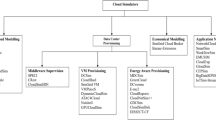Abstract
This paper aims to help find solutions for questions an early researcher may have to set up experiments in their development environment. Simultaneously, while identifying the steps required for experimenting, the authors narrowed on an experimenting toolkit for Cloud Computing as an area of their study. Because of such simulators, the cloud computing environment itself is available easily at the comfort of one’s desktop resources instead of visiting an actual physical data center to collect trace and log files as data sets for real workloads. This paper acts as an experience sharing to naive researchers who are interested in how to go about to start cloud computing setups. A new framework called Cloud Computing Simulation Environment (CCSE) is presented with inspiration from Procure Apply Consider and Transform (PACT) model to ease the learning process. The literature survey in this paper shares the path taken by researchers for understanding the architecture, technology, and tools required to set up a resilient test environment. This path also depicts the introduced framework CCSE. The parameters found out of the experiments were Virtual Machines (VMs), Cloudlets, Host, and Cores. The appropriate combination of the values of the parameters would be horizontal scaling of VMs. Increasing VMs does not influence the average execution time after a specific limit on the number of VMs allocated. Nevertheless, in vertical scaling, appropriate combinations of the cores and hosts yield better execution times. Thereby maintaining the optimal number of hosts is an ultimate saving of resources in case of VM allocations.
Access this chapter
Tax calculation will be finalised at checkout
Purchases are for personal use only
Similar content being viewed by others
References
SkillsYouNeed: What is Learning?, https://www.skillsyouneed.com/learn, last accessed 2020/08/10
Gill SS, Buyya R (2018) A taxonomy and future directions for sustainable cloud computing: 360 degree view. ACM Comput Surv 51:5. https://doi.org/10.1145/3241038
Caton S et al (2014) A social compute cloud: allocating and sharing infrastructure resources via social networks. IEEE Trans Serv Comput 7(3):359–372. https://doi.org/10.1109/TSC.2014.2303091
Buyya R et al (2011) Cloud computing. Wiley, Hoboken, NJ, USA. https://doi.org/10.1002/9780470940105
Yaghmaei O, Binesh F (2015) Impact of applying cloud computing on universities expenses. IOSR J Bus Manag Ver I. 17(2):2319–7668. https://doi.org/10.9790/487X-17214247
Barker A et al (2014) Academic cloud computing research: five pitfalls and five opportunities
Bahwaireth K et al (2016) Experimental comparison of simulation tools for efficient cloud and mobile cloud computing applications. Eurasip J Inf Secur 2016:1. https://doi.org/10.1186/s13635-016-0039-y
Buyya R et al (2009) Modeling and simulation of scalable cloud computing environments and the CloudSim toolkit: challenges and opportunities. In: Proceedings of the 2009 international conference on high performance computing and simulation, HPCS 2009. https://doi.org/10.1109/HPCSIM.2009.5192685
Azizi S et al (2020) GRVMP: a greedy randomized algorithm for virtual machine placement in cloud data centers. IEEE Syst J 1–12. https://doi.org/10.1109/JSYST.2020.3002721
Richhariya V et al (2015) Hybrid approach for load balancing in cloud computing
Rodriguez MA, Buyya R (2014) Deadline based resource provisioning and scheduling algorithm for scientific workflows on clouds. IEEE Trans Cloud Comput 2(2):222–235. https://doi.org/10.1109/TCC.2014.2314655
Faynberg I et al (2015) The business of cloud computing. In: Cloud computing, pp 7–18. Wiley, Chichester, UK. https://doi.org/10.1002/9781118736074.ch2
Bermejo B, Juiz C (2020) Virtual machine consolidation: a systematic review of its overhead influencing factors. Springer, US. https://doi.org/10.1007/s11227-019-03025-y
Xavier C (2011) Java programming: a practical approach. Tata McGraw Hill
Singh A. CloudSim Tutorials: lets bridge the gaps, https://www.CloudSimtutorials.online/CloudSim-setup-using-eclipse/, last accessed 2020/08/10
Calheiros RN et al (2015) Workload prediction using ARIMA model and its impact on cloud applications’ QoS. IEEE Trans Cloud Comput 3(4):449–458. https://doi.org/10.1109/TCC.2014.2350475
Zhu Q, Agrawal G (2012) Resource provisioning with budget constraints for adaptive applications in cloud environments. IEEE Trans Serv Comput. https://doi.org/10.1109/TSC.2011.61
Dawoud W et al (2012) Elastic virtual machine for fine-grained cloud resource provisioning. Commun Comput Inf Sci 269 CCIS, PART I, 11–25. https://doi.org/10.1007/978-3-642-29219-4_2
Buyya R et al (2019) A manifesto for future generation cloud computing: research directions for the next decade. ACM Comput Surv 51(5):1–51. https://doi.org/10.1145/3241737
Popek GJ, Goldberg RP (1973) Formal requirements for virtualizable third generation architectures. ACM SIGOPS Oper Syst Rev 7(4):121. https://doi.org/10.1145/957195.808061
Author information
Authors and Affiliations
Corresponding author
Editor information
Editors and Affiliations
Rights and permissions
Copyright information
© 2021 The Author(s), under exclusive license to Springer Nature Singapore Pte Ltd.
About this paper
Cite this paper
Sankaran, L., Subramanian, S.J. (2021). CloudSim Exploration: A Knowledge Framework for Cloud Computing Researchers. In: Thampi, S.M., Lloret Mauri, J., Fernando, X., Boppana, R., Geetha, S., Sikora, A. (eds) Applied Soft Computing and Communication Networks. Lecture Notes in Networks and Systems, vol 187. Springer, Singapore. https://doi.org/10.1007/978-981-33-6173-7_8
Download citation
DOI: https://doi.org/10.1007/978-981-33-6173-7_8
Published:
Publisher Name: Springer, Singapore
Print ISBN: 978-981-33-6172-0
Online ISBN: 978-981-33-6173-7
eBook Packages: Intelligent Technologies and RoboticsIntelligent Technologies and Robotics (R0)




